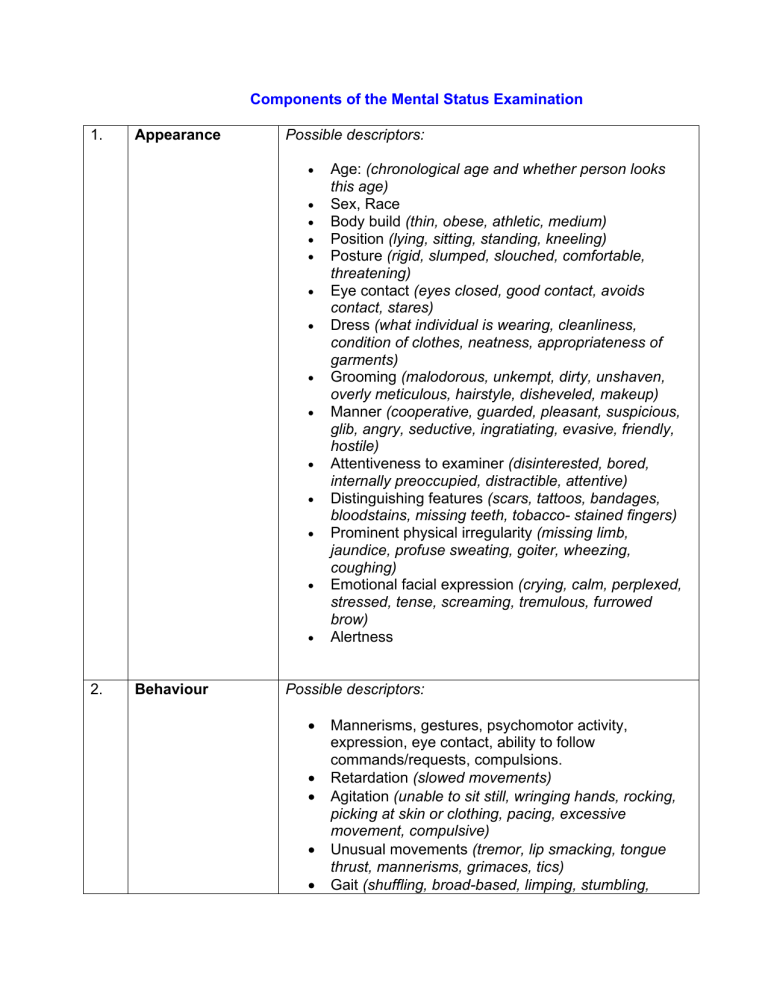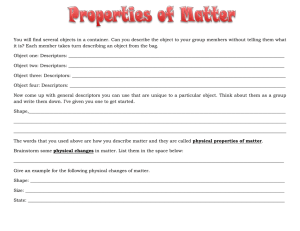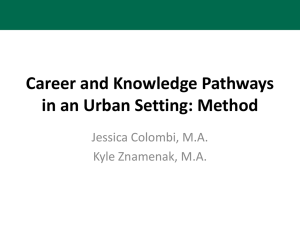
Components of the Mental Status Examination
1.
Appearance
Possible descriptors:
•
•
•
•
•
•
•
•
•
•
•
•
•
•
2.
Behaviour
Age: (chronological age and whether person looks
this age)
Sex, Race
Body build (thin, obese, athletic, medium)
Position (lying, sitting, standing, kneeling)
Posture (rigid, slumped, slouched, comfortable,
threatening)
Eye contact (eyes closed, good contact, avoids
contact, stares)
Dress (what individual is wearing, cleanliness,
condition of clothes, neatness, appropriateness of
garments)
Grooming (malodorous, unkempt, dirty, unshaven,
overly meticulous, hairstyle, disheveled, makeup)
Manner (cooperative, guarded, pleasant, suspicious,
glib, angry, seductive, ingratiating, evasive, friendly,
hostile)
Attentiveness to examiner (disinterested, bored,
internally preoccupied, distractible, attentive)
Distinguishing features (scars, tattoos, bandages,
bloodstains, missing teeth, tobacco- stained fingers)
Prominent physical irregularity (missing limb,
jaundice, profuse sweating, goiter, wheezing,
coughing)
Emotional facial expression (crying, calm, perplexed,
stressed, tense, screaming, tremulous, furrowed
brow)
Alertness
Possible descriptors:
•
•
•
•
•
Mannerisms, gestures, psychomotor activity,
expression, eye contact, ability to follow
commands/requests, compulsions.
Retardation (slowed movements)
Agitation (unable to sit still, wringing hands, rocking,
picking at skin or clothing, pacing, excessive
movement, compulsive)
Unusual movements (tremor, lip smacking, tongue
thrust, mannerisms, grimaces, tics)
Gait (shuffling, broad-based, limping, stumbling,
•
3.
Attitude
Possible descriptors:
•
4.
Level of
Consciousness
Orientation
•
•
Speech
•
•
•
•
•
•
Mood
A sustained state of
inner feeling
“What is your full name?”
“Where are we at (floor, building, city, county, and
state)?”
“What is the full date today (date, month, year, day of
the week, and season of the year)?”
“How would you describe the situation we are in?”
Possible descriptors:
•
7.
Vigilant, alert, drowsy, lethargic, stuporous, asleep,
comatose, confused, fluctuating.
Possible questions for patient:
•
•
6.
Cooperative, hostile, open, secretive, evasive,
suspicious, apathetic, easily distracted, focused,
defensive.
Possible Descriptors:
•
5.
hesitation)
Catatonia (stupor, excitement)
Rate (slowed, long pauses before answering
questions, hesitant, rapid, pressured)
Quantity (talkative, spontaneous, expansive, paucity,
poverty)
Rhythm (monotonous, stuttering)
Volume (loud, soft, whispered)
Amount (monosyllabic, hyper-talkative, mute)
Articulation (clear, mumbled, slurred)
Spontaneity
Possible questions for patient:
•
•
•
•
•
•
Mood (reported by patient/client)
“How are your spirits?”
“How are you feeling?”
“Have you been discouraged/depressed/low/blue
lately?”
“Have you been energized/elated/high/out of control
lately?”
“Have you been angry/irritable/edgy lately?”
8.
Affect
An observed
expression of inner
feeling.
Possible descriptors:
•
•
•
•
•
Stability (stable, fixed, labile)
Range (constricted, full)
Appropriateness (to content of speech &
circumstance, consistent or congruent with mood)
Intensity (flat, blunted, exaggerated)
Affect (depressed, sad, happy, euphoric, irritable,
anxious, neutral, fearful, angry, pleasant)
9.
Though Processes
/ Form
Logic, relevance,
organization, flow
and coherence of
thought in response
to general
questioning during
the interview.
Possible descriptors:
•
•
•
•
•
•
•
•
•
•
•
10.
Thought Content
•
•
•
•
•
•
•
•
•
•
Goal-directed
Circumstantial, tangential, loose associations,
Evasive
Racing
Coherence (coherent, incoherent)
Logic (logical, illogical)
Stream (goal-directed, circumstantial, tangential
{diverges suddenly from a train of thought}, loose,
flight of ideas, rambling, word salad)
Perseveration (pathological repetition of a sentence or
word)
Neologism (use of new expressions, phrases, words)
Blocking (sudden cessation of flow of thinking &
speech related to strong emotions)
Attention (distractibility, concentration)
Suicidal or homicidal ideations
Depressive cognition (guilt, worthlessness,
hopelessness)
Obsessions (persistent, unwanted, recurring thought)
Ruminations
Phobias (strong, persistent, fear of object or situation)
Ideas of reference Paranoid ideation
Magical ideation
Delusions (false belief kept despite no supportive
evidence)
Overvalued ideas
Other major themes discussed by patient/client
Possible questions for patient:
•
•
•
•
•
•
•
“What do you think about when you are sad/angry?”
“What’s been on your mind lately?”
“Do you find yourself ruminating about things?”
“Are there thoughts or images that you have a really
difficult time getting out of your head?”
“Are you worried/scared/frightened about something
or other?”
“Do you have personal beliefs that are not shared by
others?” (Delusions are fixed, false, unshared beliefs.)
“Do you ever feel
•
•
•
•
•
•
•
11.
Perceptions
•
•
•
•
12.
Suicidality and
Homicidality
detached/removed/changed/different from others
around you?”
“Do things seem unnatural/unreal to you?”
“What do you think about the reports in papers such
as The National Enquirer?”
“Do you think someone or some group intend to harm
you in some way?”
[In response to something the patient says] “What do
you think they meant by that?”
“Does it ever seem like people are stealing your
thoughts, or perhaps inserting thoughts into your
head? Does it ever seem like your own thoughts are
broadcast out loud?”
“Do you ever see (visual), hear (auditory), smell
(olfactory), taste (gustatory), and feel (tactile) things
that are not really there, such as voices or visions?”
(Hallucinations are false perceptions)
“Do you sometimes misinterpret real things that are
around you, such as muffled noises or shadows?”
(Illusions are misinterpreted perceptions)
Hallucinations (auditory, visual, olfactory [smelling],
gustatory [taste], tactile)
Illusions (misinterpretation of actual external stimuli)
Depersonalization
Déjà vu, Jamais vu
Possible questions for patient:
A. Suicidality –
•
•
•
“Do you ever feel that life isn’t worth living? Or that
you would just as soon be dead?”
“Have you ever thought of doing away with yourself?
If so, how?”
“What would happen after you were dead?”
B. Homicidality –
•
•
13.
Insight &
“Do you think about hurting others or getting even with
people who have wronged you?”
“Have you had desires to hurt others? If so, how?”
Possible questions for patient:
Judgment
•
•
•
•
•
•
•
•
•
•
•
14.
Attention Span
“What brings you here today?”
“What seems to be the problem?”
“What do you think is causing your problems?”
“How do you understand your problems?”
“How would you describe your role in this situation?”
“Do you think that these thoughts, moods,
perceptions, are abnormal?”
“How do you plan to get help for this problem?”
“What will you do when _____________ occurs?”
“How will you manage if ____________ happens?”
“If you found a stamped, addressed envelope on the
street, what would you do with it?”
“If you were in a movie theater and smelled smoke,
what would you do?”
Possible descriptors:
•
Attend, concentration, distractibility.
A. Digit Span (forward and reverse) - Suggested patient
instructions:
• “I will recite a series of numbers to you, and then I will
ask you to repeat them to me, first forwards and then
backwards.” [Begin with 3 numbers – not consecutive
numbers, and advance to 7-8 numbered sequence.]
B. Spelling Backwards - Suggested patient instructions:
• “Spell the word ‘world.’ Now spell the word ‘world’
backwards.”
C. Calculations - Suggested patient instructions:
• (Serial 7’s) “Starting with 100, subtract 7 from 100,
and then keep subtracting 7 from that number as far
as you can go.”
• (Serial 3’s) “Starting with 20, subtract 3 from 20, and
then keep subtracting 3 from that number as far as
you can go.” [Monitor for speed, accuracy, effort
required, and monitor patient reactions to the request]
• “Add these numbers: (15 + 12 + 7)”
• “Multiply these numbers: (25 x 6)”
• “If something costs 78 cents and you give the cashier
one dollar, how much change should you get back?”
15.
Memory
Possible questions for patient:
A. Recent Memory –
• “What is my name?”
• “What medications did you take today?”
• “What time was your appointment with me for today?”
B. Remote Memory –
• “Where were you when President Kennedy was
shot?” (For patients over 40)
• “What is your Social Security number?”
• “What were the dates of your graduation from high
school, college, graduate school?”
• “When and where did you get married?”
C. Immediate Memory (also see XIII.-A. above) and New
Learning - Suggested patient instructions:
• “I am going to ask you to remember three words
(color, object, animal – e.g., blue, table, and horse)
and I will ask you to repeat them to me in 5 minutes.
Please repeat them now after me: blue, table, and
horse.” – 5 minutes elapse – “What were those three
words I asked you to remember?” [Monitor accuracy
of response, awareness of whether responses are
correct, tendency to confabulate or substitute other
words, ability to correct themselves with category clue
and multiple choice].
16.
Intellectual
Functioning
A. Information and Vocabulary - Suggested patient
instructions:
• “Name the last 5 presidents.” (Clinton, Bush, Reagan,
Carter, Ford, Nixon, …)
• “Name 5 of the largest cities in the country.” (New
York City, Los Angeles, Chicago, Houston,
Philadelphia)
• “Name the current president, vice president, governor,
and mayor.” (Bill Clinton, Al Gore, George Ryan,
Richard M. Daley)
B. Vocabulary - Possible descriptors:
• Grade school level, high school level, fluent,
consistent with education.
C. Abstraction - Possible questions for patient:
1. Similarities – “How are the following items similar?”
• “an apple and an orange” (round ~concrete, fruit
~abstract)
•
•
“a chair and a table” (made of wood ~concrete,
furniture ~abstract)
“a watch and a ruler” (measurement instruments
~abstract)
2. Proverbs – “How would you describe the meaning of the
following sayings?”
• “People living in glass houses should not throw
stones.”
• “A bird in the hand is worth two in the bush.”
• “You shouldn’t cry over spilt milk.”
• “Two heads are better than one.”





